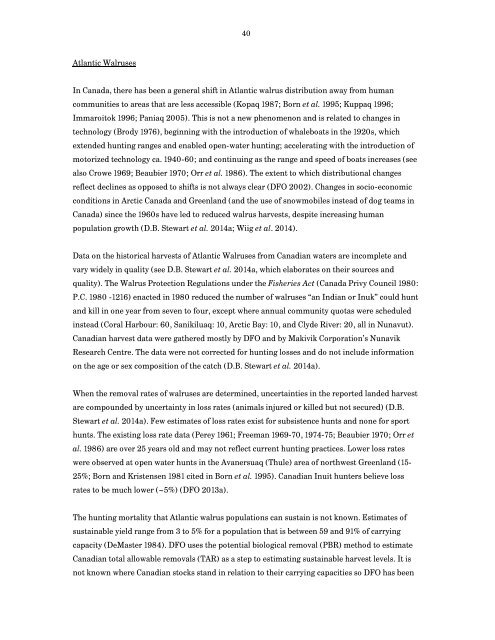The State of Circumpolar Walrus Populations
walrusreport
walrusreport
Create successful ePaper yourself
Turn your PDF publications into a flip-book with our unique Google optimized e-Paper software.
40<br />
Atlantic <strong>Walrus</strong>es<br />
In Canada, there has been a general shift in Atlantic walrus distribution away from human<br />
communities to areas that are less accessible (Kopaq 1987; Born et al. 1995; Kuppaq 1996;<br />
Immaroitok 1996; Paniaq 2005). This is not a new phenomenon and is related to changes in<br />
technology (Brody 1976), beginning with the introduction <strong>of</strong> whaleboats in the 1920s, which<br />
extended hunting ranges and enabled open-water hunting; accelerating with the introduction <strong>of</strong><br />
motorized technology ca. 1940-60; and continuing as the range and speed <strong>of</strong> boats increases (see<br />
also Crowe 1969; Beaubier 1970; Orr et al. 1986). <strong>The</strong> extent to which distributional changes<br />
reflect declines as opposed to shifts is not always clear (DFO 2002). Changes in socio-economic<br />
conditions in Arctic Canada and Greenland (and the use <strong>of</strong> snowmobiles instead <strong>of</strong> dog teams in<br />
Canada) since the 1960s have led to reduced walrus harvests, despite increasing human<br />
population growth (D.B. Stewart et al. 2014a; Wiig et al. 2014).<br />
Data on the historical harvests <strong>of</strong> Atlantic <strong>Walrus</strong>es from Canadian waters are incomplete and<br />
vary widely in quality (see D.B. Stewart et al. 2014a, which elaborates on their sources and<br />
quality). <strong>The</strong> <strong>Walrus</strong> Protection Regulations under the Fisheries Act (Canada Privy Council 1980:<br />
P.C. 1980 -1216) enacted in 1980 reduced the number <strong>of</strong> walruses “an Indian or Inuk” could hunt<br />
and kill in one year from seven to four, except where annual community quotas were scheduled<br />
instead (Coral Harbour: 60, Sanikiluaq: 10, Arctic Bay: 10, and Clyde River: 20, all in Nunavut).<br />
Canadian harvest data were gathered mostly by DFO and by Makivik Corporation’s Nunavik<br />
Research Centre. <strong>The</strong> data were not corrected for hunting losses and do not include information<br />
on the age or sex composition <strong>of</strong> the catch (D.B. Stewart et al. 2014a).<br />
When the removal rates <strong>of</strong> walruses are determined, uncertainties in the reported landed harvest<br />
are compounded by uncertainty in loss rates (animals injured or killed but not secured) (D.B.<br />
Stewart et al. 2014a). Few estimates <strong>of</strong> loss rates exist for subsistence hunts and none for sport<br />
hunts. <strong>The</strong> existing loss rate data (Perey 1961; Freeman 1969-70, 1974-75; Beaubier 1970; Orr et<br />
al. 1986) are over 25 years old and may not reflect current hunting practices. Lower loss rates<br />
were observed at open water hunts in the Avanersuaq (Thule) area <strong>of</strong> northwest Greenland (15-<br />
25%; Born and Kristensen 1981 cited in Born et al. 1995). Canadian Inuit hunters believe loss<br />
rates to be much lower (~5%) (DFO 2013a).<br />
<strong>The</strong> hunting mortality that Atlantic walrus populations can sustain is not known. Estimates <strong>of</strong><br />
sustainable yield range from 3 to 5% for a population that is between 59 and 91% <strong>of</strong> carrying<br />
capacity (DeMaster 1984). DFO uses the potential biological removal (PBR) method to estimate<br />
Canadian total allowable removals (TAR) as a step to estimating sustainable harvest levels. It is<br />
not known where Canadian stocks stand in relation to their carrying capacities so DFO has been


